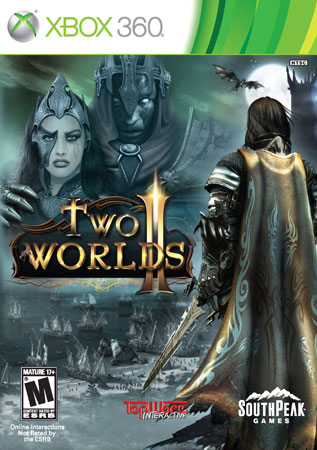
In 2007, Reality Pump brought Two Worlds to the PC and Xbox 360. This month they released the follow up, Two Worlds II, in the US after a November launch in Europe. After I’ve traveled and quested for many an hour through Antaloor, here’s my take on the sequel.
It’s no secret that the original Two Worlds released in America to mixed and often confused reviews. Targets of scorn were the iffy graphics, the entirely in-house voice work, and an awkward interface. A lot of the negative criticism arose from problems that happened in the game’s translation from its original German to English. Indeed, the original Two Worlds saw much higher review scores in Europe than in America. The second installment in the series feels like it took a lot of the criticism of the first game to heart, as many of the systems and aspects of Two Worlds II are refined and just plain work and look a lot better than they did the first time around. Interestingly, it seems that some of the localization gripes have been embraced, as the game often intentionally straddles the gap between straight up epic fantasy and weirdly goofy self parody.
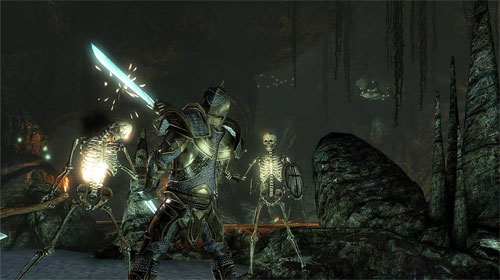
This is no Deadly Premonition, though. The silliness here feels entirely intentional, from the weirdly unique quest goals that start popping up around Chapter 2 to the occasional and blatant anachronisms. At its core, Two Worlds II is a very good and solid RPG that is determined to eat dozens of hours of your life. Admittedly, some of the graphics still look a little dated, and some of the character animations could use some work, but you’ll likely get past those speed bumps sometime between the start of the game and your escape from the tutorial dungeon. What really works about the game is the underlying system that is as addictive as it is immersive. It just takes a little digging and patience to get into it.
The voice work throughout Two Worlds II is a little uneven, with some characters sounding fantastic and others sounding like the office mail boy came in to record some lines. That actually lends a little charm to the game, though. It’s easy to see that the people making the game really cared about it and wanted players to be immersed and to have a great time, and none of that is hindered by the occasional seams showing up in the production.
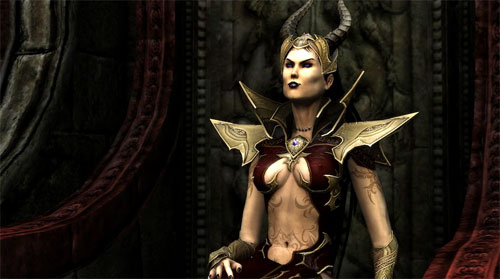
The story starts with some pretty typical fantasy fare. You and your sister have been captured by the evil lord Gandohar. Your sister is playing host to some sort of demonic presence that just might give Gandohar an upper hand in his plans for world domination. A motley band of orcs quickly shows up to dispatch your prison guards, springing you free to teleport out of the castle with them. There’s no time to save your sister, so you’ll have to keep a post-it note to go back for her later. Your escape lands you in the orc lands, where you’ll learn the game’s various systems through some serviceable tutorial missions and actions.

At the core of the game is a trio of crafting systems. Each of the three systems works pretty differently from the others, but all three provide an extra layer of depth to the game, and each is accompanied by a somewhat awkward acronym. The CRAFT system allows you to augment your weapons and armor by combining them with base materials like wood, iron, and leather. You also can add magic gems and dyes into the mix. You can even break down already assembled equipment into their own basic elements to then use for awesomeifying another item in your inventory. DEMONS is the game’s spellcrafting system, and it’s pretty complicated but can yield some fantastically satisfying magic. You’ll use elemental cards and amulets to combine and modify spell effects to suit your needs. Spellcrafting can yield everything from a simple fireball to a lightning area of effect attack that immediately is followed by anvils dropping from the sky. The final system is PAPAK, used for alchemy. PAPAK is a little simplistic in comparison to the other two crafting systems, as it just requires you to select a few components from your inventory to brew up into a tasty poultice.
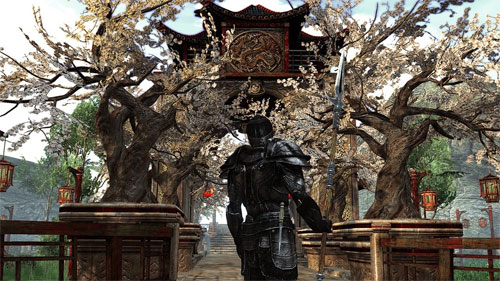
Since crafting is such a big part of the game, it should come as no surprise that there’s a whole branch of the leveling up tree devoted to making and modifying your stuff. And since there are no traditional classes in character creation for Two Worlds II, there also are progression areas for melee, ranged combat, and magic, not to mention rogue skills and basic character attributes. As you play the game and get a feel for what you enjoy and want to do, you’ll be able to customize your character’s entire progression. It’s a bit like Oblivion in that way, and indeed Two Worlds II‘s open world and plethora of quests and characters fits squarely into the genre inhabited by The Edler Scrolls.
There’s a little bit of a learning curve to Two Worlds II, as the crafting systems can be a little obscure at first, and there’s not a lot of good explanation for some of the game elements. Items in your inventory, for example, have plenty of stats to look at, but the icons that represent the stats are not explained anywhere in-game or in the manual. There’s an option in Settings to switch from iconic stats to text, and I highly suggest you do that early. Another good early game suggestion is to turn off autosaving, as counter intuitive as that might seem. Autosave is turned on by default, and you can specify how often the game with save itself. The actual act of saving is an obviously taxing process that fully freezes the game for a few seconds, though, and nothing is more infuriating or jarring than to have that happen to you mid-combat, resulting in your entirely unnecessary death once things start back up again. If you do turn off autosave (and you should), make sure you manually save early and often. Dying is easy in this game, and you don’t want to replay half an hour because you ran afoul of a random rhino or fruit-chucking primate.
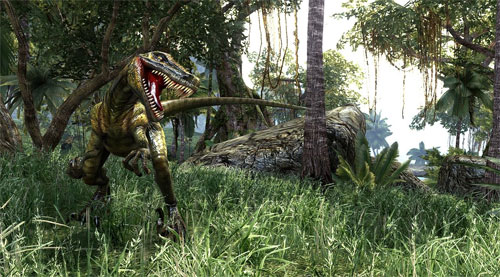
Once you get past the learning curve and accept the graphics and animations for what they are, Two Worlds II really is a great game. There’s a ton to see and do, and it will keep you busy with all its crazy questing, traveling, and crafting. The main draw will be the massive single player game, but there are a couple of unique multiplayer modes included as well. This really is a full featured game that improves on nearly every problem present in the first game. If you’re feeling the itch for some good open world roleplaying, this just might be your fix.






